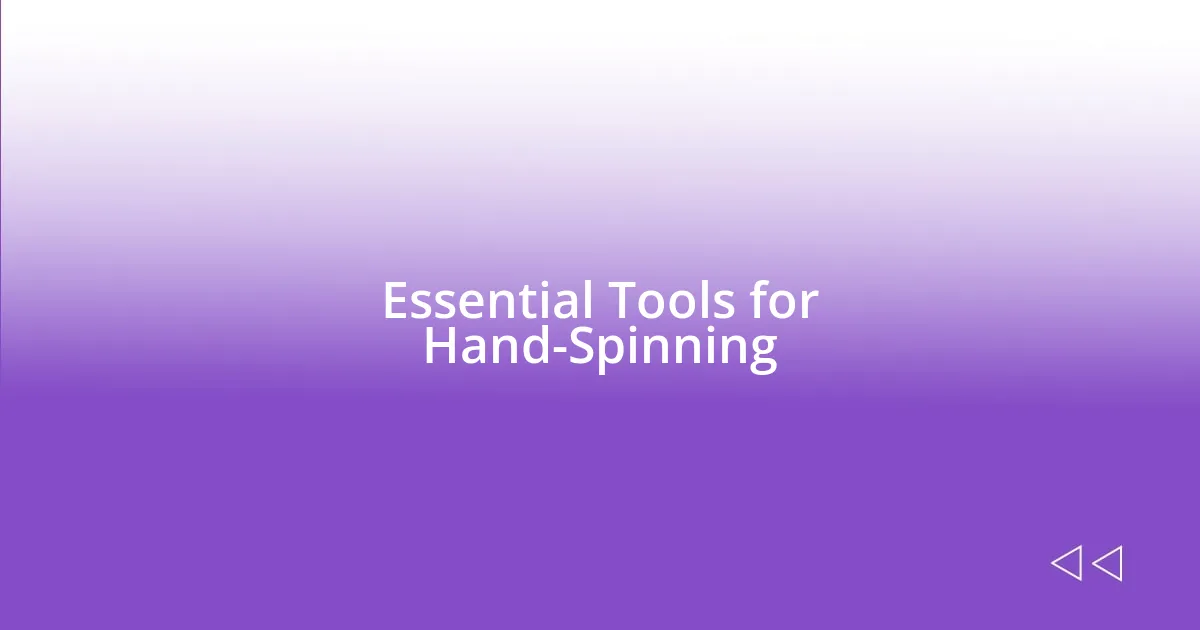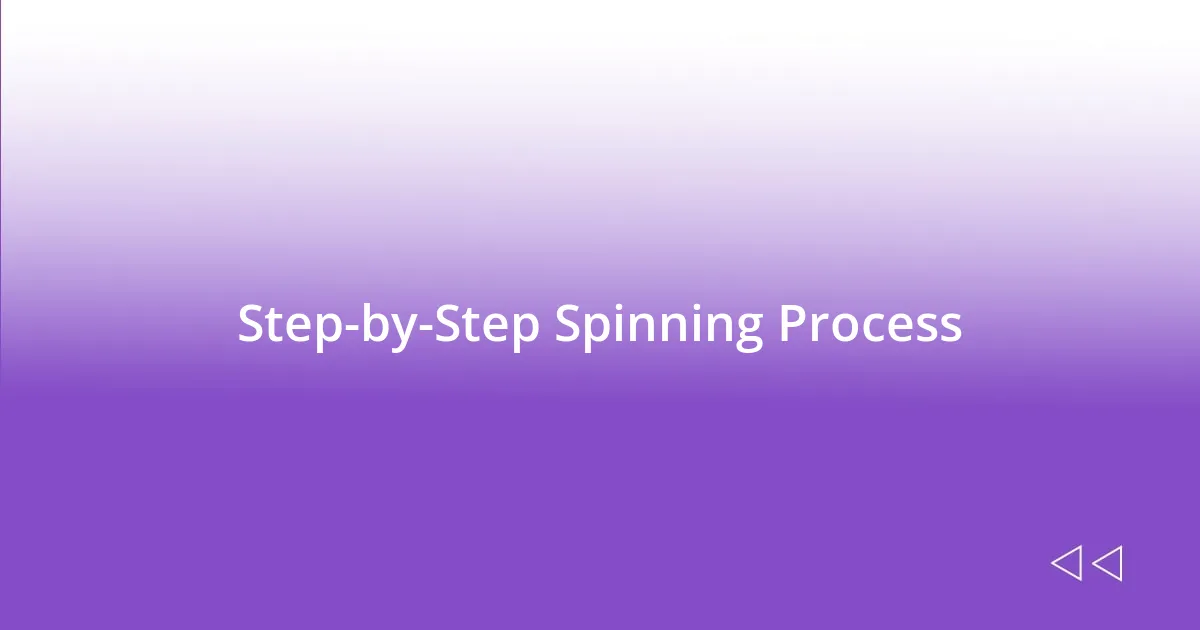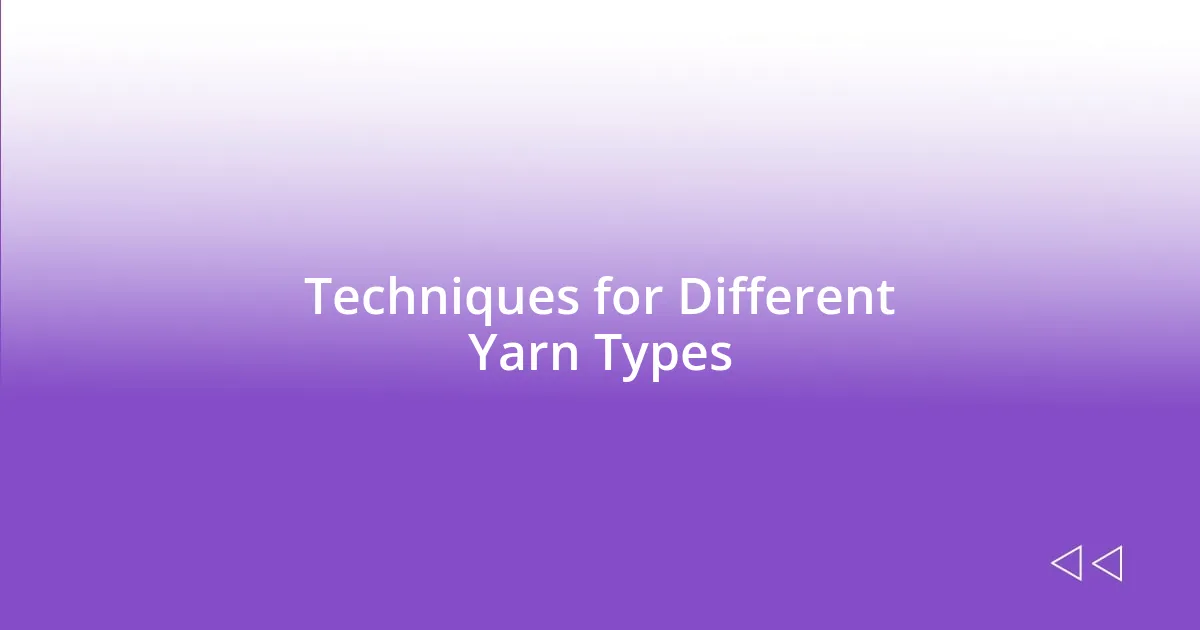Key takeaways:
- Hand-spinning wool is a meditative and creative process that connects crafters to nature and tradition.
- Choosing the right wool type impacts the project’s outcome and experience; qualities like softness and texture are crucial.
- Essential tools, such as a balanced spindle and distaff, enhance the spinning experience, making it more enjoyable and effective.
- Caring for finished yarn, including proper storage and washing, is vital for preserving quality and enhancing its usability.

Introduction to Hand-Spinning Wool
Hand-spinning wool has a charm that pulls you in, doesn’t it? I still remember the first time I sat down with a spindle; the fiber felt like a cloud in my hands, waiting to be transformed. It’s an ancient craft that connects us to our forebears, reminding us of a time when handmade was the only way to create textiles.
As I began my journey into hand-spinning, I felt a mix of excitement and curiosity. The rhythmic motion of twisting and pulling the fibers was meditative, almost like a form of moving meditation. Have you ever experienced that sense of peace when your hands are busy, and your mind is free to wander? For me, each strand became not just a thread, but a story waiting to be woven.
Diving into this art really opened my eyes to the beauty of the materials involved. There’s a wonderful satisfaction in preparing wool, carding it, and watching the transformation as it becomes yarn. It’s more than just a process; it’s a tactile connection to nature and creativity, stirring emotions that you might not expect to feel while simply spinning wool.

Benefits of Hand-Spinning Wool
Hand-spinning wool offers numerous benefits that go beyond the simple act of creating yarn. For me, one of the primary joys is the therapeutic effect it brings. I often find myself lost in the gentle motion, and it’s almost like a form of self-care. I can vividly recall those days when stress seemed overwhelming; picking up my spindle provided an instant refuge. The simple act of spinning fibers helped ground my thoughts, creating a serene space away from the hustle of daily life.
Another significant advantage is the connection to sustainable practices. Choosing my own wool and spinning it by hand increases my awareness of where my materials come from. It’s a fulfilling experience to know that I’m using natural fibers and supporting local shepherds. I often feel a sense of pride when I knit something from yarn I spun myself—it feels like a personal accomplishment and a small step towards mindful living.
Finally, hand-spinning fosters creativity in a profound way. I’ve discovered that the colors and textures I create are entirely unique. Each batch of yarn tells a story, influenced by my emotional state and inspiration at the moment. I remember spinning a deep blue yarn during a rainy week; it perfectly captured that calm, reflective mood. It’s not just craft; it’s a personal expression that I can wear or gift, turning what once was just fiber into cherished pieces of art.
| Benefit | Description |
|---|---|
| Therapeutic Effect | Creates a calming, meditative state |
| Sustainable Practices | Supports local farmers and uses natural materials |
| Fosters Creativity | Allows for unique color and texture experimentation |

Choosing the Right Wool
Choosing the right type of wool is critical in hand-spinning, as it significantly impacts the finished product and your overall experience. I’ve experimented with various fibers, and let me say, discovering the unique characteristics of each type is like going on a little adventure. For example, merino wool is incredibly soft and great for beginner projects, while rougher fibers like Romney can add texture and durability to your yarn. The first time I used alpaca wool, I was astonished by its warmth and luxurious feel—it really changes how you view the craft.
Here are some factors to consider when choosing your wool:
- Softness: Merino is soft and gentle against the skin, perfect for garments.
- Strength: Wools like Romney are more robust, ideal for items that need durability.
- Texture: Different breeds offer varied textures—from smooth to coarse, influencing the yarn’s final look.
- Weight: Think about whether you want a fine or bulky yarn for your project.
- Color: Natural sheep colors can add depth, or you can dye your own for unique shades.
Each choice adds a layer to your creative process, shaping what you create and how it feels to your fingertips as you spin. I often reflect on how each wool selection is a stepping stone in my learning journey, making every project an opportunity for growth and experimentation.

Essential Tools for Hand-Spinning
When it comes to hand-spinning, having the right tools is essential for a smooth experience. I can’t emphasize enough how a good spindle can make all the difference. The first time I tried using a well-balanced drop spindle, I was amazed at how easily the fiber twisted and turned. It felt like a natural extension of my hand, guiding me effortlessly through the spinning process.
Another must-have is a distaff, especially if you’re working with long wool locks. I remember my initial struggles with loose fibers flying all over the place. Once I started using a distaff, everything changed. It allowed me to manage the wool more efficiently and keep my workspace tidy. It’s all about creating a comfortable environment where your creativity can flow.
Lastly, don’t underestimate the importance of a quality fiber bowl or storage container. I’ve learned the hard way that keeping my wool organized not only prevents tangles but also enhances my enjoyment. There’s a certain joy in having everything in its place, making each spinning session feel like a cozy retreat, almost like coming home to a well-loved craft. So, what about you? Have you found tools that enhance your experience?

Step-by-Step Spinning Process
The spinning process begins with drafting the fiber, which involves gently pulling it apart to prepare it for spinning. I vividly remember my first attempt at this; I was nervous and thought I might ruin the wool. But, as I learned to control the draft, it felt like I was orchestrating a beautiful symphony of fibers, flowing smoothly through my fingers. The thrill of transforming fluffy wool into something cohesive is truly magical.
Once you’ve drafted the fiber, it’s time to spin! I always find this part exhilarating. You pinch the fiber with one hand while the other twirls the spindle or wheel, allowing the fibers to twist together. I can still recall the moment I first felt that satisfying tug as the fibers connected. It was like my heart raced in sync with the whirl of the spindle. Throughout this step, I learned about tension; maintaining the right amount keeps the yarn uniform and manageable. It’s a dance, really—finding that perfect rhythm becomes intuitive over time.
After you’ve spun your yarn to the desired thickness, it’s crucial to set the twist. I used to overlook this step, thinking it was unimportant until I encountered uneven results. I now understand that soaking the yarn and then gently hanging it to dry not only locks the twist in place but also helps to soften the fibers. Have you ever felt the difference between freshly spun yarn and one that’s been properly finished? It’s day and night! This step not only enhances the yarn’s texture but also makes it ready for the project it was intended for.

Techniques for Different Yarn Types
When it comes to yarn types, each one requires a slightly different approach to get the best results. For instance, when I spin fine merino wool, I take extra care to draft the fiber exceptionally thin. I remember the first time I attempted to create laceweight yarn. It felt like I was tiptoeing on a tightrope, balancing the delicate fibers without breaking them. That moment of tension, both physical and emotional, was exhilarating!
Now, let’s talk about working with coarser fibers, like Romney or Icelandic wool. I’ve found that these require a more relaxed drafting process, allowing the texture of the wool to shine through. I distinctly recall the clunky, rustic feel when I first spun Icelandic fleece. At first, I thought I was ruining the yarn, but as I embraced its character, I started to appreciate the beautiful, lofty fabric it could create. Isn’t it fascinating how changing your technique can unlock a whole new world of creativity?
Lastly, blends can be a delightful challenge! When I spin a combination of wool and silk, I’ve learned that maintaining moisture in the fiber can greatly affect the outcome. One time, while spinning a merino-silk blend, I forgot to spritz the fiber lightly with water. The result was uneven and frustrating. It was a humbling lesson that taught me how essential it is to consider the unique properties of each fiber in a blend. Have you experimented with different types? The discoveries are often where the real joy lies!

Caring for Finished Yarn
Caring for finished yarn can be just as important as the spinning process itself. I vividly remember the first time I neglected to store my newly spun skeins properly. I left them in a sunny spot and, to my horror, the colors faded. Since then, I’ve learned that keeping yarn in a cool, dry, and dark place is essential. It really makes a difference in preserving those vibrant hues.
Once the yarn is safely stored, I always make sure to wash it before use, especially if it carries any lingering oils from the spinning process. A gentle wash with some wool soap not only cleans but also brings out the softness. I remember the first project I tackled with unwashed yarn—it was scratchy and not at all what I envisioned. After washing, the yarn transformed into a cloud-like softness that was a joy to work with. Have you had experiences like that, where a small step changes everything?
Lastly, consider the tools you use with your finished yarn. I’ve found that using wooden needles or hooks can enhance the overall experience. When I switched to bamboo needles, I felt a noticeable improvement in how the yarn glided through. It’s funny how the right tools can turn a good project into a great one, isn’t it? Always take the time to care for your yarn and the tools you use; it truly enhances your crafting journey!












